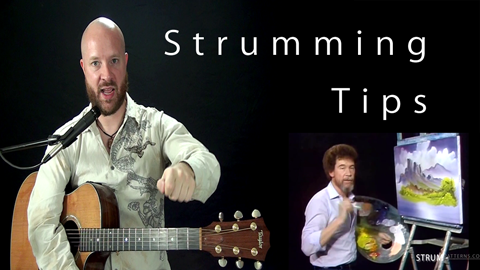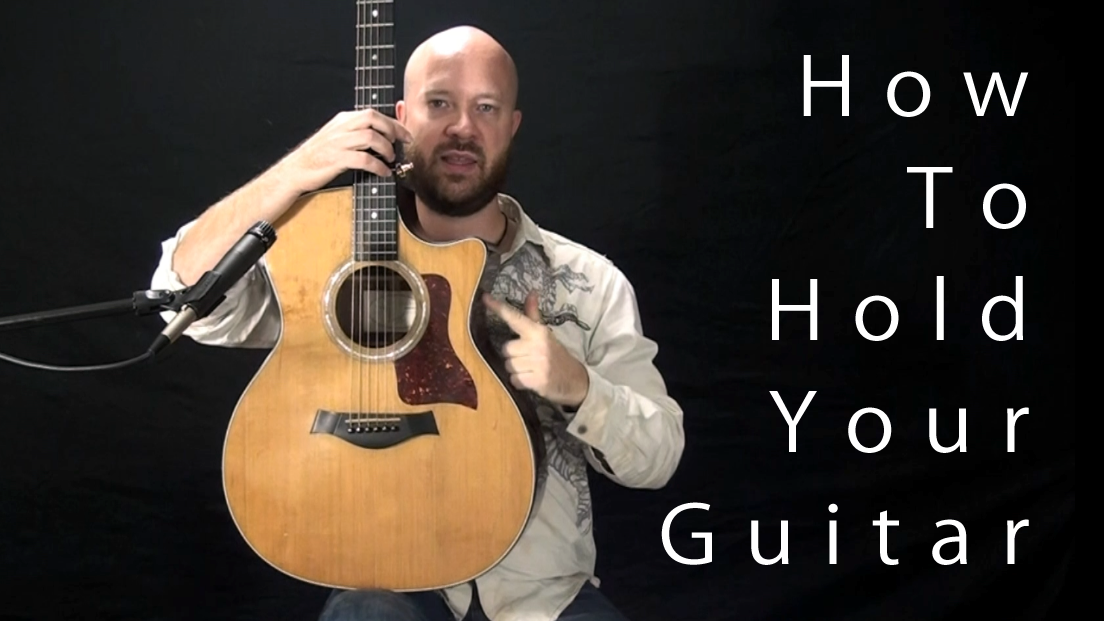How to hold the guitar, part 1
In addition to this article, I have since created a video that illustrates many of the topics discussed here.
Today we're going to take a look at holding the guitar. It's an area that many guitarists rarely, if ever consider. But they should!!! I know I hadn't considered the way I held the guitar for a long time, and when I finally did, it was well worth the effort to break the habit. If you've not concentrated on it before, you will have to be constantly rechecking your position to see if it's changed while playing. There are many ways to hold the guitar depending on the style you're playing. Today we're going to focus on holding acoustic guitars, though most of the principles will apply to electrics and classical guitars as well.
Having a good position will help you in a lot ways. The first and most important is to prevent you from damaging your wrists and developing carpal tunnel syndrome. Once you develop it, the only way to fix it is surgery, so it's best to make sure you don't get it. Also, a good position helps you stay relaxed and comfortable. When I first started playing, I would get tired after playing for less than an hour. Now I can play for hours and hours and keep going, and that has nothing to do with endurance. It also helps you increase your speed, dexterity, and relieve a lot of the extra pressure you're wasting. Once you improve your position, you'll be able to play faster, play chords you couldn't play, and your ability to stretch will improve.
I'm writing directions with right handed guitarists in mind. So if you're a lefty, just be sure to swap them.
So let's begin. First you want to place the guitar in your lap with the sound hole facing out from you. The curve of the guitar should fit comfortably on the leg you place it on. Classical guitarists place the guitar on the left leg, while rock, folk and other popular styles usually place it on their right. Choose whatever is appropriate for your style and comfort. You will want the guitar tilted back at a small angle (approx. 10-20 degrees). Some guitarists tilt the guitar too far back because they want to be able to see their hands on the fretboard. But this is a bad habit, and will hurt your position and as a result your technique will suffer. Guitars usually have small dots on the side of the neck to help you find your position. It takes a little to get used to using these dots if you've been watching your fretboard, but it's worth getting used to. Besides the slight tilt, you will want to make sure the head of the guitar is higher than the body. Many beginning guitarists make the mistake of letting the head tilt down so that it's lower than the body. That makes it very hard to play, creates a dangerous bend in your wrist and will limit the range of your fretting hand.
Now that you've got the arch of the guitar on the right leg, the body at a slight angle back, and the head up, you're ready to advance. You want your right arm over the top of the body, close to the tail of the body. How far back depends on your height, but when your arm is in position, your hand should comfortably come to the very center of the sound hole.
The chair or what you are sitting on is also important. You want  to make sure that when you are seated you can sit up straight and not have to slump over the guitar. If you do have to slump over, you need to do something to elevate the guitar. One way to do this is to use a foot stand
to make sure that when you are seated you can sit up straight and not have to slump over the guitar. If you do have to slump over, you need to do something to elevate the guitar. One way to do this is to use a foot stand
or stack of books underneath the foot supporting the guitar. Otherwise you need to elevate the leg by crossing it. If you do that you have to be sure to find a position you can sit in comfortably for a long period of time.
So now your guitar should be touching you in three points. One spot is the leg, the second is the bottom of your bicep, and the third is the upper part of your chest. With the guitar being held gently in place by these three parts, you should be able to balance the guitar in your lap so that the head of the guitar is up and you don't need to use your hands. This is crucial-- you don't have to use your hands to keep the guitar steady.
Once you've got the guitar comfortably balancing in your lap, we can now focus on your left hand. The idea for your left hand is you want one straight line from your knuckles to your elbow. No bending your wrist!!!! If you bend your wrist, this will create tension while you play, and that can lead to a repetitive motion injury. Pretend your left arm is in a cast and you cannot move your wrist. When your hand touches the guitar it needs to be straight. To do this, you have to have the head of the guitar up. I also have the guitar at an angle so that the neck is leading away from me and the body is closer to my ribs. You don't need a big angle (approx. 20-3o degrees should be fine) for this to work.
That's about it for the seated position. Holding your guitar the right way will make a big difference in your hand position, and as a result your overall technique. You should sit in front of mirror sometimes and watch yourself play. When you do, watch and make sure you don't have any tension in your shoulders, face, or hands as you play. Some of the faces some of my students make while playing are hilarious. But, I wouldn't want to watch them make those faces onstage.
When standing, the idea is pretty much the same. One difference is that since you can't tilt the guitar back, the guitar will be straight against your body. You will still keep the head of the guitar up (somewhere close to shoulder level depending on height) and keep the body angled out from you. I keep the guitar more to my right hip as I play, which allows my elbows to drop straight down to the floor as well as keep my wrist straight on my fretting hand.
Hope that helps! Give the new position a try for awhile and you'll find your playing improves. Tension in your body is the number one enemy of playing the guitar well and the biggest reason your favorite guitar hero can do what he can do and you find it impossible.
This is one of a few things you can change that most guitarists  never even think about. It's unfortunate because it is so important. If you want to read more about this and several other related topics, there's an excellent book called The Principles of Correct Practice for Guitar . Not incredibly exciting material, but great information and worth it's weight in gold!
never even think about. It's unfortunate because it is so important. If you want to read more about this and several other related topics, there's an excellent book called The Principles of Correct Practice for Guitar . Not incredibly exciting material, but great information and worth it's weight in gold!









